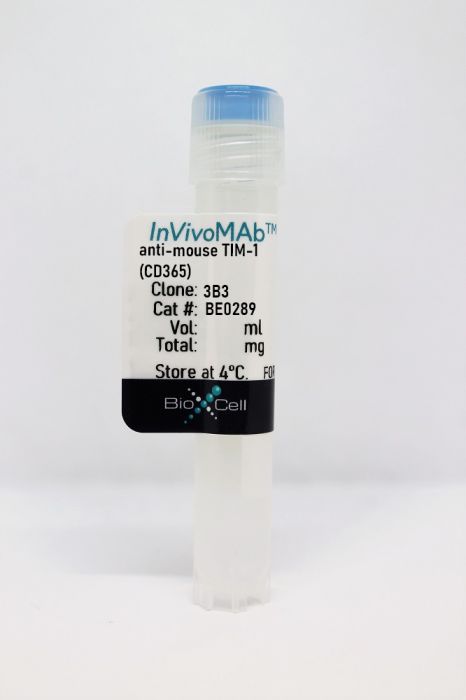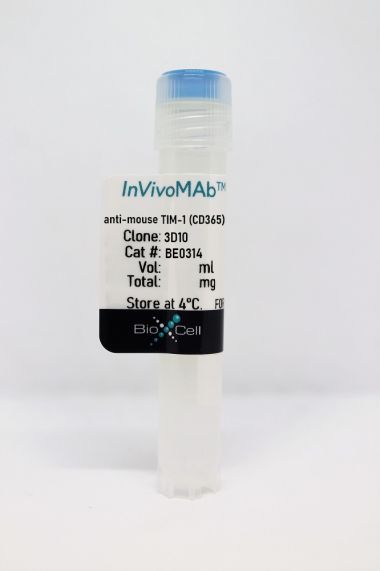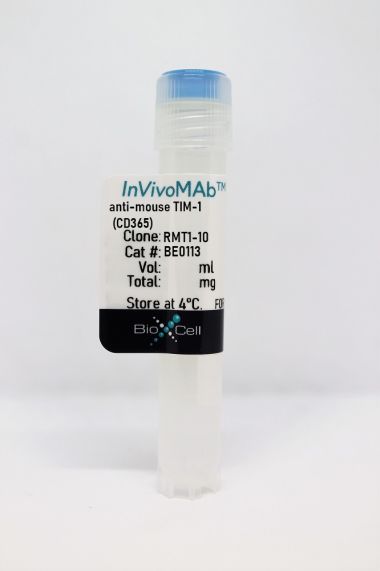InVivoMAb anti-mouse TIM-1 (CD365)
Product Details
The 3B3 monoclonal antibody reacts with mouse T cell immunoglobulin and mucin domain 1 (TIM-1) also known as CD365. TIM-1 is a type I cell-surface glycoprotein and member of the Ig superfamily. TIM-1 is preferentially expressed on TH2 cells and has been identified as a stimulatory molecule for T cell activation. The TIM gene family, plays critical roles in regulating the immune response to viral infection. TIM-1 is also involved in allergic responses, asthma, and transplant tolerance. The 3B3 antibody is an agonistic antibody and has been shown to activate TIM-1 in vivo and in vitro resulting in the hyperproliferation of T cells and induction of proinflammatory cytokine production.Specifications
| Isotype | Rat IgG2a, κ |
|---|---|
| Recommended Isotype Control(s) | InVivoMAb rat IgG2a isotype control, anti-trinitrophenol |
| Recommended Dilution Buffer | InVivoPure pH 7.0 Dilution Buffer |
| Conjugation | This product is unconjugated. Conjugation is available via our Antibody Conjugation Services. |
| Immunogen | Mouse TIM-1 (signal and IgV domains)/mouse IgG2a Fc fusion protein |
| Reported Applications |
in vivo TIM-1 activation in vitro T cell stimulation/activation Functional assays ELISA Flow cytometry |
| Formulation |
PBS, pH 7.0 Contains no stabilizers or preservatives |
| Endotoxin |
<2EU/mg (<0.002EU/μg) Determined by LAL gel clotting assay |
| Purity |
>95% Determined by SDS-PAGE |
| Sterility | 0.2 µm filtration |
| Production | Purified from cell culture supernatant in an animal-free facility |
| Purification | Protein G |
| RRID | AB_2687812 |
| Molecular Weight | 150 kDa |
| Storage | The antibody solution should be stored at the stock concentration at 4°C. Do not freeze. |
Recommended Products
Functional Assays
Lee, H. H., et al. (2010). "Apoptotic cells activate NKT cells through T cell Ig-like mucin-like-1 resulting in airway hyperreactivity" J Immunol 185(9): 5225-5235. PubMed
T cell Ig-like mucin-like-1 (TIM-1) is an important asthma susceptibility gene, but the immunological mechanisms by which TIM-1 functions remain uncertain. TIM-1 is also a receptor for phosphatidylserine (PtdSer), an important marker of cells undergoing programmed cell death, or apoptosis. We now demonstrate that NKT cells constitutively express TIM-1 and become activated by apoptotic cells expressing PtdSer. TIM-1 recognition of PtdSer induced NKT cell activation, proliferation, and cytokine production. Moreover, the induction of apoptosis in airway epithelial cells activated pulmonary NKT cells and unexpectedly resulted in airway hyperreactivity, a cardinal feature of asthma, in an NKT cell-dependent and TIM-1-dependent fashion. These results suggest that TIM-1 serves as a pattern recognition receptor on NKT cells that senses PtdSer on apoptotic cells as a damage-associated molecular pattern. Furthermore, these results provide evidence for a novel innate pathway that results in airway hyperreactivity and may help to explain how TIM-1 and NKT cells regulate asthma.
in vivo TIM-1 activation
Mariat, C., et al. (2009). "Tim-1 signaling substitutes for conventional signal 1 and requires costimulation to induce T cell proliferation" J Immunol 182(3): 1379-1385. PubMed
Differentiation and clonal expansion of Ag-activated naive T cells play a pivotal role in the adaptive immune response. T cell Ig mucin (Tim) proteins influence the activation and differentiation of T cells. Tim-3 and Tim-2 clearly regulate Th1 and Th2 responses, respectively, but the precise influence of Tim-1 on T cell activation remains to be determined. We now show that Tim-1 stimulation in vivo and in vitro induces polyclonal activation of T cells despite absence of a conventional TCR-dependent signal 1. In this model, Tim-1-induced proliferation is dependent on strong signal 2 costimulation provided by mature dendritic cells. Ligation of Tim-1 upon CD4(+) T cells with an agonist anti-Tim-1 mAb elicits a rise in free cytosolic calcium, calcineurin-dependent nuclear translocation of NF-AT, and transcription of IL-2. Because Tim-4, the Tim-1 ligand, is expressed by mature dendritic cells, we propose that interaction between Tim-1(+) T cells and Tim-4(+) dendritic cells might ensure optimal stimulation of T cells, when TCR-derived signals originating within an inflamed environment are weak or waning.
in vitro T cell stimulation/activation
Degauque, N., et al. (2008). "Immunostimulatory Tim-1-specific antibody deprograms Tregs and prevents transplant tolerance in mice" J Clin Invest 118(2): 735-741. PubMed
T cell Ig mucin (Tim) molecules modulate CD4(+) T cell responses. In keeping with the view that Tim-1 generates a stimulatory signal for CD4(+) T cell activation, we hypothesized that an agonist Tim-1-specific mAb would intensify the CD4(+) T cell-dependant allograft response. Unexpectedly, we determined that a particular Tim-1-specific mAb exerted reciprocal effects upon the commitment of alloactivated T cells to regulatory and effector phenotypes. Commitment to the Th1 and Th17 phenotypes was fostered, whereas commitment to the Treg phenotype was hindered. Moreover, ligation of Tim-1 in vitro effectively deprogrammed Tregs and thus produced Tregs unable to control T cell responses. Overall, the effects of the agonist Tim-1-specific mAb on the allograft response stemmed from enhanced expansion and survival of T effector cells; a capacity to deprogram natural Tregs; and inhibition of the conversion of naive CD4(+) T cells into Tregs. The reciprocal effects of agonist Tim-1-specific mAbs upon effector T cells and Tregs serve to prevent allogeneic transplant tolerance.
in vitro T cell stimulation/activation, ELISA, in vivo TIM-1 activation
Xiao, S., et al. (2007). "Differential engagement of Tim-1 during activation can positively or negatively costimulate T cell expansion and effector function" J Exp Med 204(7): 1691-1702. PubMed
It has been suggested that T cell immunoglobulin mucin (Tim)-1 expressed on T cells serves to positively costimulate T cell responses. However, crosslinking of Tim-1 by its ligand Tim-4 resulted in either activation or inhibition of T cell responses, thus raising the issue of whether Tim-1 can have a dual function as a costimulator. To resolve this issue, we tested a series of monoclonal antibodies specific for Tim-1 and identified two antibodies that showed opposite functional effects. One anti-Tim-1 antibody increased the frequency of antigen-specific T cells, the production of the proinflammatory cytokines IFN-gamma and IL-17, and the severity of experimental autoimmune encephalomyelitis. In contrast, another anti-Tim-1 antibody inhibited the generation of antigen-specific T cells, production of IFN-gamma and IL-17, and development of autoimmunity, and it caused a strong Th2 response. Both antibodies bound to closely related epitopes in the IgV domain of the Tim-1 molecule, but the activating antibody had an avidity for Tim-1 that was 17 times higher than the inhibitory antibody. Although both anti-Tim-1 antibodies induced CD3 capping, only the activating antibody caused strong cytoskeletal reorganization and motility. These data indicate that Tim-1 regulates T cell responses and that Tim-1 engagement can alter T cell function depending on the affinity/avidity with which it is engaged.
in vitro T cell stimulation/activation, Flow Cytometry, Functional Assays
Umetsu, S. E., et al. (2005). "TIM-1 induces T cell activation and inhibits the development of peripheral tolerance" Nat Immunol 6(5): 447-454. PubMed
We have examined the function of TIM-1, encoded by a gene identified as an ‘atopy susceptibility gene’ (Havcr1*), and demonstrate here that TIM-1 is a molecule that costimulates T cell activation. TIM-1 was expressed on CD4(+) T cells after activation and its expression was sustained preferentially in T helper type 2 (T(H)2) but not T(H)1 cells. In vitro stimulation of CD4(+) T cells with a TIM-1-specific monoclonal antibody and T cell receptor ligation enhanced T cell proliferation; in T(H)2 cells, such costimulation greatly enhanced synthesis of interleukin 4 but not interferon-gamma. In vivo, the use of antibody to TIM-1 plus antigen substantially increased production of both interleukin 4 and interferon-gamma in unpolarized T cells, prevented the development of respiratory tolerance, and increased pulmonary inflammation. Our studies suggest that immunotherapies that regulate TIM-1 function may downmodulate allergic inflammatory diseases.
- Cancer Research,
- Immunology and Microbiology
Carcinogen exposure enhances cancer immunogenicity by blocking the development of an immunosuppressive tumor microenvironment.
In The Journal of Clinical Investigation on 16 October 2023 by Huang, M., Xia, Y., et al.
PubMed
Carcinogen exposure is strongly associated with enhanced cancer immunogenicity. Increased tumor mutational burden and resulting neoantigen generation have been proposed to link carcinogen exposure and cancer immunogenicity. However, the neoantigen-independent immunological impact of carcinogen exposure on cancer is unknown. Here, we demonstrate that chemical carcinogen-exposed cancer cells fail to establish an immunosuppressive tumor microenvironment (TME), resulting in their T cell-mediated rejection in vivo. A chemical carcinogen-treated breast cancer cell clone that lacked any additional coding region mutations (i.e., neoantigen) was rejected in mice in a T cell-dependent manner. Strikingly, the coinjection of carcinogen- and control-treated cancer cells prevented this rejection, suggesting that the loss of immunosuppressive TME was the dominant cause of rejection. Reduced M-CSF expression by carcinogen-treated cancer cells significantly suppressed tumor-associated macrophages (TAMs) and resulted in the loss of an immunosuppressive TME. Single-cell analysis of human lung cancers revealed a significant reduction in the immunosuppressive TAMs in former smokers compared with individuals who had never smoked. These findings demonstrate that carcinogen exposure impairs the development of an immunosuppressive TME and indicate a novel link between carcinogens and cancer immunogenicity.
- Mus musculus (House mouse),
- Immunology and Microbiology,
- Stem Cells and Developmental Biology
Regulatory T Cells in Skin Facilitate Epithelial Stem Cell Differentiation.
In Cell on 1 June 2017 by Ali, N., Zirak, B., et al.
PubMed
The maintenance of tissue homeostasis is critically dependent on the function of tissue-resident immune cells and the differentiation capacity of tissue-resident stem cells (SCs). How immune cells influence the function of SCs is largely unknown. Regulatory T cells (Tregs) in skin preferentially localize to hair follicles (HFs), which house a major subset of skin SCs (HFSCs). Here, we mechanistically dissect the role of Tregs in HF and HFSC biology. Lineage-specific cell depletion revealed that Tregs promote HF regeneration by augmenting HFSC proliferation and differentiation. Transcriptional and phenotypic profiling of Tregs and HFSCs revealed that skin-resident Tregs preferentially express high levels of the Notch ligand family member, Jagged 1 (Jag1). Expression of Jag1 on Tregs facilitated HFSC function and efficient HF regeneration. Taken together, our work demonstrates that Tregs in skin play a major role in HF biology by promoting the function of HFSCs. Copyright © 2017 Elsevier Inc. All rights reserved.





